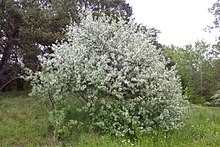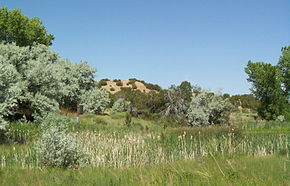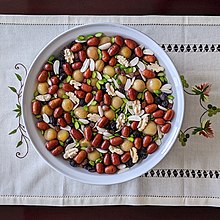Elaeagnus angustifolia
| Elaeagnus angustifolia | |
|---|---|

| |
| Scientific classification | |
| Kingdom: | Plantae |
| Clade: | Tracheophytes |
| Clade: | Angiosperms |
| Clade: | Eudicots |
| Clade: | Rosids |
| Order: | Rosales |
| Family: | Elaeagnaceae |
| Genus: | Elaeagnus |
| Species: | E. angustifolia
|
| Binomial name | |
| Elaeagnus angustifolia | |
| Synonyms[1] | |
|
List
| |
Elaeagnus angustifolia, commonly called Russian olive,[2] silver berry,[3] oleaster,[3] or wild olive,[3] is a species of Elaeagnus, native to Asia and limited areas of eastern Europe. It is widely established in North America as an introduced species.[4][5]
Description
[edit]Elaeagnus angustifolia is a thorny tree growing to 35 feet (11 metres) in height.[6] Its stems, buds, and leaves have a dense covering of silvery to rusty scales. The leaves are alternate, lanceolate, 4–9 centimetres (1+1⁄2–3+1⁄2 inches) long and 1–2.5 cm (3⁄8–1 in) broad, with a smooth margin. The plants begin to flower and fruit from 3 years old. The highly aromatic flowers, produced in clusters of one to three, are 1 cm long with a four-lobed creamy yellow calyx; they appear in early summer and are followed by clusters of fruit, a small cherry-like drupe 1–1.7 cm (3⁄8–5⁄8 in) long, orange-red covered in silvery scales. The fruits are about 1 cm wide[7] and sweet, though with a dryish, mealy texture.[8][9][10]
The species is established and reproduced primarily by seed, with some vegetative propagation also occurring.[11] The branches have thorns that can be 2–7 cm (3⁄4–2+3⁄4 in) long.
Taxonomy
[edit]The first scientific description of Elaeagnus angustifolia was by Carl Linnaeus under its present name in 1753.[1] Its common name comes from its similarity in appearance to the olive (Olea europaea), in a different botanical family, the Oleaceae.
According to Sudnik et al. (2009) "Most authors suggest that Elaeagnus angustifolia originated from the Irano-Turanian region.The species is widely distributed in south-west Asia. In the East its range extends from Kashmir and north-west India to eastern Kazakhstan. The western limit of the species distribution is unclear; the natural character of the tree stands in the lower Volga region(Golub et al. 2002) and Anatolia (Brow ic z1996) is questioned." Further east in Asia the native range stretches into Afghanistan, Iran, Kazakhstan, Kyrgyzstan, Pakistan, Tajikistan, Turkmenistan, and the nations of the Caucasus. In India they are found in the western Himalayas. There is a disjunct population in Myanmar and Assam in eastern India. They grow natively in Mongolia and in China they are found in the north-central, southeast, Inner Mongolia, Manchuria, Qinghai, and Xinjiang.[1]
Ecology
[edit]
The shrub possesses a very high level of nitrogen fixation(Page 6) and salinity tolerance [1][12] enabling it to grow on bare mineral substrates and poor, eroded soils and environments.
The caterpillars of the high altitude alpine moth Lachana alpherakii use it as a host plant.[13] The fruit is readily eaten and the seeds disseminated by many species of birds.
Invasive behavior
[edit]The species was introduced into North America by the late 19th century, and was both planted and spread through the consumption of its fruits (which seldom ripen in England),[14] by birds, which disperse the seeds.[11] Russian olive is considered to be an invasive species in many places in the United States because it thrives on poor soil, has high seedling survival rates, matures in a few years, and out-competes the native vegetation. It often invades riparian habitats where the canopy of cottonwood trees has died. Its quick-spreading root system can make it pest-like.
Uses
[edit]
It is widely grown across southern and central Europe as a drought and cold-resistant ornamental plant for its scented flowers, edible fruit,[7] attractive yellow foliage and black bark.[11] It was grown in England by John Parkinson no later than 1633.[15]
In Iran, the dried powder of the fruit is used mixed with milk for rheumatoid arthritis and joint pains. There is evidence supporting beneficial effects of aqueous extract of Persian olive in reducing the symptoms of osteoarthritis with an efficacy comparable to that of acetaminophen and ibuprofen.[16]
It is one of the seven items used in Haft-sin, a traditional table setting of Nowruz, the traditional Persian spring celebration. The dried fruit, known locally as senjed, is one of seven served in its own syrup in a fruit salad called haft mēwa eaten during Nowruz in Afghanistan.[17][18]

In folk herbalism Russian olive has a wide variety of uses. The leaves, fruit, flowers, and bark are all employed. The leaves are known to help in the gastrointestinal system, assist in wound healing and are used as an antibacterial. The fruit has a wide range of traditional applications, including use as an anti-inflammatory and antioxidant. The flowers are a traditional remedy for fevers, made as an herbal infusion. [19][20]
In urban settings, landscapers use plantings of Russian olive to discourage the homeless from resting or sleeping in the location.[21]
Chemistry
[edit]E. angustifolia contains the alkaloids harmine, harmane, and harmol in the roots and shoot, as well as calligonine in the bark.[22]
References
[edit]- ^ a b c "Elaeagnus angustifolia L." Plants of the World Online. Royal Botanic Gardens, Kew. Retrieved 30 April 2024.
- ^ "Russian Olive Species Profile". USDA. Retrieved 2016-01-10.
- ^ a b c Bailey, L. H.; Bailey, E. Z.; the staff of the Liberty Hyde Bailey Hortorium (1976). Hortus third: A concise dictionary of plants cultivated in the United States and Canada. New York: Macmillan. ISBN 978-0-02-505470-7.
- ^ Sullivan, Steven. K. (2020). "Elaeagnus angustifolia". Wildflower Search. Retrieved 2020-09-22.
- ^ USDA, NRCS. (2020). "Elaeagnus angustifolia". The PLANTS Database. National Plant Data Team, Greensboro, NC 27401-4901 USA. Retrieved 2020-09-22.
- ^ "USDA Plants Database".
- ^ a b Arno, Stephen F.; Hammerly, Ramona P. (2020) [1977]. Northwest Trees: Identifying & Understanding the Region's Native Trees (field guide ed.). Seattle: Mountaineers Books. pp. 287–288. ISBN 978-1-68051-329-5. OCLC 1141235469.
- ^ Klinkenberg, Brian, ed. (2020). "Elaeagnus angustifolia". E-Flora BC: Electronic Atlas of the Plants of British Columbia [eflora.bc.ca]. Lab for Advanced Spatial Analysis, Department of Geography, University of British Columbia, Vancouver. Retrieved 2020-09-22.[permanent dead link]
- ^ Giblin, David, ed. (2020). "Elaeagnus angustifolia". WTU Herbarium Image Collection. Burke Museum, University of Washington. Retrieved 2020-09-22.
- ^ "Elaeagnus angustifolia". in Jepson Flora Project (eds.) Jepson eFlora. Jepson Herbarium; University of California, Berkeley. 2020. Retrieved 2020-09-22.
- ^ a b c Little, Elbert L. (1994) [1980]. The Audubon Society Field Guide to North American Trees: Western Region (Chanticleer Press ed.). Knopf. p. 566. ISBN 0-394-50761-4.
- ^ "Forest Service Fire Ecology". Archived from the original on 2008-04-05. Retrieved 2008-01-15.
- ^ Trofimova, Tatyana A. (January 2008). "Systematic notes on Dasorgyia Staudinger, 1881, Dicallomera Butler, 1881, and Lachana Moore, 1888 (Lymantriidae)" (PDF). Nota Lepidopterologica. 31 (2): 273–291. ISSN 0342-7536. Archived from the original (PDF) on 23 April 2012. Retrieved 26 November 2019.
- ^ Parkinson noted that it rarely perfected its fruit (noted by Coats 1992).
- ^ Coats, Alice M.; Creech, John L. (1992). Garden Shrubs and Their Histories (1st US ed.). New York: Simon and Schuster. p. 75. ISBN 978-0-671-74733-6. Retrieved 2 May 2024.
- ^ Panahi, Y.; Alishiri, G. H.; Bayat, N.; Hosseini, S. M.; Sahebkar, A. (2016). "Efficacy of Elaeagnus Angustifolia extract in the treatment of knee osteoarthritis: A randomized controlled trial". Excli Journal. 15: 203–210. PMC 4908661. PMID 27330526.
- ^ Sethi, Simran (2022-03-21). "Nowruz is banned in Afghanistan, but families continue to celebrate". NPR. Retrieved 2022-04-29.
- ^ Deravian, Naz (2022-03-14). "For Afghans Abroad, Nowruz Is a Chance to Reflect". The New York Times. ISSN 0362-4331. Retrieved 2022-04-29.
- ^ Farzaei, Mohammad Hosein; Bahramsoltani, Roodabeh; Abbasabadi, Zahra; Rahimi, Roja (2015-11-01). "A comprehensive review on phytochemical and pharmacological aspects of Elaeagnus angustifolia L." Journal of Pharmacy and Pharmacology. 67 (11): 1467–1480. doi:10.1111/jphp.12442. ISSN 2042-7158.
- ^ Hamidpour, Rafie; Hamidpour, Soheila; Doostmohamadi, Parvin (2019-09-03). "Chemistry, Pharmacology and Medicinal Property of Russian olive (Elaeagnus angustifolia L.)". Cancer Science & Research: Open Access. 6 (1): 1–7. doi:10.15226/csroa.2019.00151. ISSN 2372-0921.
- ^ Fenton, Mike. Discouraging Loiterers by Design Security Management, 01 May 2008.
- ^ "Elaeagnus angustifolia | Plant | Dr. Duke's Phytochemical and Ethnobotanical Databases". phytochem.nal.usda.gov. Retrieved 2024-01-21.
External link
[edit]- Jepson Manual Treatment
- Species Profile – Russian Olive (Elaeagnus angustifolia), National Invasive Species Information Center, United States National Agricultural Library Lists general information and resources for Russian olive
- "Elaeagnus angustifolia". Calflora. Berkeley, California: The Calflora Database.
- Elaeagnus angustifolia in the CalPhotos photo database, University of California, Berkeley
- USDA Plants Profile



